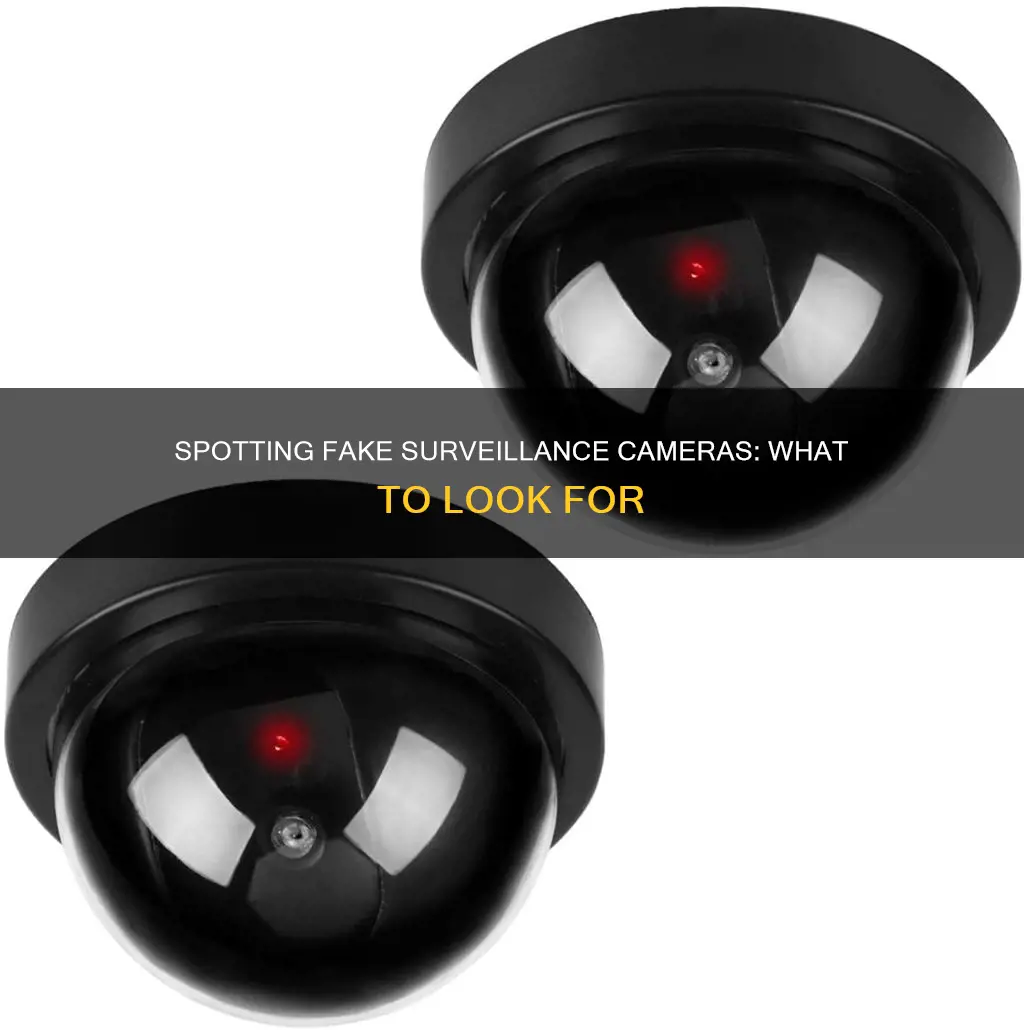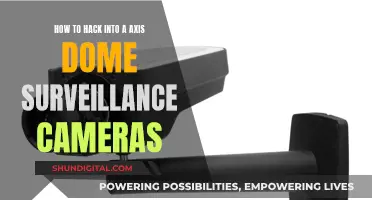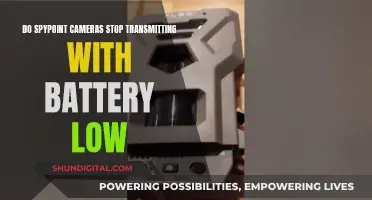
Fake security cameras are designed to mislead people into thinking they're being watched and recorded. While this may deter some petty criminals, experienced thieves are unlikely to be fooled. So, how can you tell if a security camera is real or fake? Here are some tell-tale signs:
- Indicator lights: Real security cameras often have small LED indicator lights, but fake cameras may have overly bright or constantly flashing lights to draw attention.
- Motion sensing: Genuine security cameras have motion sensors that adjust the camera's position or trigger recording. Fake motion sensors may be either non-functional or overly sensitive, reacting in an exaggerated or uniform way.
- Build quality: Fake cameras often feel flimsy, have visible seams, or lack weatherproofing features. Authentic cameras are built to withstand tampering and outdoor conditions.
- Placement: Fake cameras are often placed in improbable locations or lack essential components like wiring. Well-placed and convincingly designed fakes can sometimes deter casual trespassers.
- Branding: Fake cameras often mimic real brands, but the model numbers don't exist upon closer inspection. They may also lack finer details like serial numbers or brand-specific design elements.
- Cables: Real cameras usually have thick cables for data and power transfer, while fake cameras have thin cables to cut costs. Older cameras may have two cables, so multiple cables don't always indicate authenticity.
- Price: Real cameras with advanced features like motion tracking tend to be more expensive. If a camera looks affordable and swivels, it's likely fake.
While these signs can help, the best way to confirm a camera's authenticity is to check the brand and model online.
| Characteristics | Values |
|---|---|
| Lights | Real cameras rarely have bright, flashing lights. Fake cameras often have blinking red lights to attract attention. Real cameras use infrared technology to record at night, producing a faint glow. |
| Cables | Fake cameras often have thin cables or multiple cables. Real cameras usually have one thick cable for data transfer and power transmission. |
| Motion Tracking | Fake cameras may swivel at regular intervals or randomly to mimic motion tracking. Real cameras with motion-tracking capabilities use specialised sensors and do not swivel. |
| Wi-Fi Signal | Wireless real cameras will show up as Wi-Fi devices on your phone. Fake cameras will not appear as Wi-Fi signals. |
| Branding | Real cameras have prominent brand names displayed. Fake cameras may have no branding, fake brands, or altered logos and markings. |
| Build Quality | Fake cameras are often made of cheap plastic with visible seams and lack weatherproofing. Real cameras have robust construction with high-quality materials and attention to detail. |
| Placement | Fake cameras are often placed in protected areas, while real cameras can be placed anywhere outdoors. |
What You'll Learn

Bright, flashing lights are a sign of a fake camera
Bright, flashing lights are a tell-tale sign of a fake surveillance camera. These lights are often red and are designed to attract attention and make people believe that the property is being monitored. However, this is a false sense of security as these cameras do not record any footage.
Real security cameras rarely have blinking red lights, as this would give away their position. Criminals have also become wise to this feature and now associate flashing lights with fake cameras. Therefore, a bright, flashing light is a big indicator that a camera is not genuine.
Modern security cameras typically use infrared lights to see in the dark. These emit faint red lights, which can be seen up close or through a phone camera, but they do not blink or flash. So, if you see a camera with a flashing light, it is likely a fake.
It is worth noting that some real security cameras do have blinking lights, but these are usually different-coloured LEDs that indicate the camera's operational status, such as network connection or battery life. These lights are often not bright or obvious and are meant to signal the user, not deter criminals.
In summary, if you see a surveillance camera with bright, flashing lights, it is likely a fake designed to deter casual criminals. Real security cameras tend to avoid attention-grabbing features and rely on infrared technology to monitor their surroundings discreetly.
Vivint Camera Deter Mode: How Does It Work?
You may want to see also

Real cameras have thick cables
One of the most reliable indicators for distinguishing between a real and a dummy surveillance camera is the presence of thick cables. Real security cameras require a variety of cables to function properly, and these cables are typically sizable in diameter and clearly visible. These cables serve multiple purposes, including providing power to the camera, transmitting video data, and sometimes even supporting audio capabilities.
The power cable is typically the thickest and most noticeable. It supplies the necessary electricity to power the camera and any associated lighting. Real cameras often have visible power cables that run from the camera to a power source, such as an outlet or a power adapter. On the other hand, dummy cameras may have fake power cables that are thinner and non-functional, or they may lack any visible cables at all.
Data transmission cables are another important consideration. Real security cameras capture and transmit video data, often in high definition, and sometimes even support live streaming. These capabilities require substantial data transfer, which is typically facilitated by noticeable Ethernet cables or coaxial cables. Dummy cameras may have thin, fake cables that serve no actual purpose, or they may attempt to mimic the real thing with faux cable connections.
Additionally, some real security cameras have audio capabilities, enabling them to record sound alongside the video footage. These cameras require additional cables for audio transmission, which are often thicker and more substantial than those of dummy cameras. The presence of audio cables can be a strong indicator that a camera is functional and part of a comprehensive surveillance system.
Verkada Cameras: Where Are They Manufactured?
You may want to see also

Fake cameras often swivel
How to Tell if a Surveillance Camera is Fake
A swivel head is a feature often found on fake surveillance cameras. Both dome and bullet-style cameras are available with a swivel head that can move from side to side periodically. However, true motion-sensing cameras will never swivel when someone walks by. They simply record the event without making any physical movements. This is because motion tracking requires a lot of technology and cost, which even real cameras cannot do at the moment, let alone dummy ones.
In addition, fake cameras that swivel usually only rotate back and forth continuously, so an observant criminal may be aware that the unit is fake.
Therefore, if you notice a surveillance camera that swivels, it may be a fake.
The Patriotic Kodak: USA-Made Cameras?
You may want to see also

Wireless real cameras will show up on your phone
Firstly, real security cameras rarely have blinking red lights. This feature is common in fake cameras to attract attention and create the impression of authenticity. Modern security cameras, however, typically have infrared or IR lights that enable night vision. These IR lights appear as faint, glowing red lights that can be seen up close or through a phone camera.
Secondly, the number and type of cables can be indicative. Most modern security cameras have a single thick cable, similar to a standard home internet cable. Older cameras may have two cables, and a single thin cable usually indicates a fake camera.
Thirdly, the quality and material of the camera can be a telling sign. Fake security cameras are often made of cheap plastic, while real cameras are generally constructed with at least medium-quality materials to ensure durability.
Additionally, the presence of a brand name can be a good indicator. Fake cameras may display fake or altered brand names, so it's worth searching the brand online to verify its authenticity.
Lastly, the installation place can provide some clues. Real security cameras, especially those with IP66 & IP65 ratings, can be placed outdoors and withstand the elements. Fake cameras, on the other hand, often have fragile plastic housing and need to be placed in protected areas to avoid damage from wind and rain.
Finding the Battery Switch on Your Kidizoom Camera
You may want to see also

Fake cameras lack branding
The presence or absence of branding is a key indicator of whether a security camera is real or fake. Virtually all security cameras available on the market will feature branding somewhere on the camera. This can be the name of the camera in a distinct, custom-made font, or a logo. Even in the rare case that a camera doesn't have obvious branding on it, you'll still find the company name somewhere on it (e.g. at the bottom). A complete absence of branding is highly indicative of a fake security camera.
Fake security cameras often attempt to overcome the lack of branding by including stickers to attach to the camera, or, less commonly, made-up branding on the camera itself. The latter is rare because the cost of manufacturing casing with branding on it is much higher than without. Branding is important to a real product; you'll never find it confined to a sticker on an actual security camera, and in most cases, it'll be very deliberate. If in doubt, you can always Google the brand to see if it's real.
In addition to checking for branding, there are several other ways to spot a fake security camera. One is to check the cables. Most IP cameras used in home security utilise a single USB cable. Since USB cables are so common, you'll easily notice anything out of the ordinary; the thickness, weight, and material used can be a strong indication of a fake cable, which will have no components inside of it. A real one will have a recognisable thickness and weight to it. Realistic-looking security cameras usually don't have obvious cables hanging out of them, as homeowners typically attempt to hide security camera cables in or along walls for aesthetic reasons. Prominent cables, particularly multiple cables, can be an indication of a fake camera.
Another way to spot a fake is to check the build quality of the camera. Fake security cameras are usually made of cheap plastic, whereas real security cameras are typically made of waterproof aluminium. A fake camera will also be very lightweight, as there are no internal components.
Finally, you can check for IR lights. These will be visible inside the lens of most real security cameras as small, dull red dots, signifying the use of motion detection in the camera. They're easier to spot if the lighting around the camera is diminished. IR lights will rarely be visible in fake security cameras. If you peer into the lens, there may be no lights at all. Fake security cameras with red lights usually have them on the outside of the camera, such as a red 'on' button.
Disabling Surveillance Cameras: A Step-by-Step Guide
You may want to see also
Frequently asked questions
If the camera has blinking lights, it is likely to be fake. Real cameras rarely have blinking lights, instead, they use infrared technology to record at night, resulting in a faint glow. Fake cameras often try to mimic this glow but end up with overly bright lights.
Check the cables. Fake cameras often use thin cables, whereas real cameras will have thicker cables to transfer data and transmit power. If there are multiple cables, it's likely fake as real cameras typically use one cable for both functions.
Check the build quality. Fake cameras are often made of cheap plastic, whereas real cameras are built with durable materials to withstand weather conditions and tampering. Look for visible seams, a lack of weatherproofing features, and fragile construction.
Fake cameras are often placed in protected areas, such as under eaves or ceilings, as they cannot withstand harsh weather conditions. Real cameras, especially those with IP66 & IP65 ratings, can be placed anywhere outdoors.
Real cameras often have brand names prominently displayed. If a camera lacks obvious branding or displays an unfamiliar brand, it may be fake. Search the brand online to verify its legitimacy.
Indicators of a fake camera include blinking lights, thin cables, poor build quality, protected placement, and a lack of branding or unfamiliar branding.







